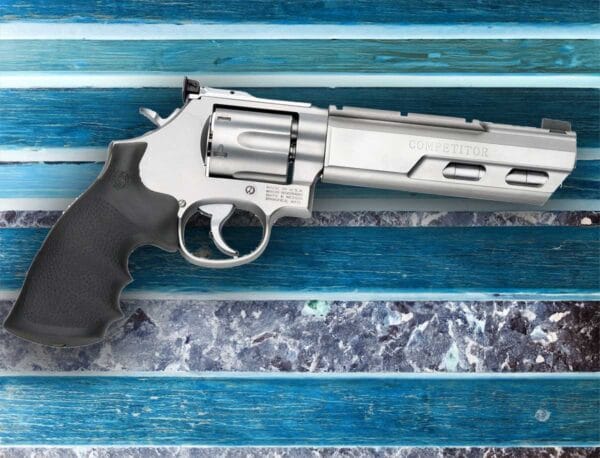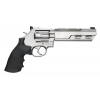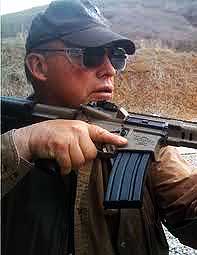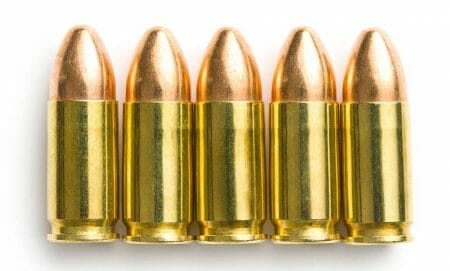Opinion
“But always there is present this feeling of unexplained relations of events” ~ Charles Fort.

Handgun Hunting!
For the first time in my life, I went big-game handgun hunting yesterday!
Vicki and I were at Shawnee Ridge in OH.
I used my S&W 629 (six-inch barrel, 44 Magnum, iron sights) with Cor-Bon (original manufacturer) 225gr DPX (all copper) ammunition.
I was able to get within fifteen meters of a 150lb Barbary ram (broadside, partially obscured by a tree trunk), and I put a single round, via trigger-cocking mode, into the animal’s chest.
The bullet broke the ram’s shoulder, blew off the top of his heart, traversed 30cm (12 inches), and came to rest just under the skin on the opposite side. We recovered the bullet, fully expanded but in one piece. It performed as advertised!
Upon being struck, the animal began to walk away, but both my guide and I were convinced it would fall over after only a few wobbly steps, as we were both confident of a solid hit.
We were both wrong!
The ram ran several hundred meters before finally collapsing, and we had to chase it all the way!
Interestingly, Vicki shot an identically-sized ram with her M4 (5.56×45, 55 gr Defiant TCX) an hour later, at a range of seventy-five meters, broadside, and the bullet struck in nearly the same spot. That bullet penetrated the same amount of animal flesh but went through and through and was not recovered. From the exit wound, I am confident it expanded as designed. The animal’s heart was blown to pieces!
Upon being struck, the ram dropped instantly, kicked a few times, but never took another step, dying in place, DRT.
I am persuaded what made the difference in terminal effect between my shot and Vicki’s is velocity!
My single 44 Magnum bullet impacted at 1350 f/s. Vicki’s 55gr 223 bullet impacted at 3100 f/s, and that substantial additional velocity is what brought about the difference in outcomes.
This instantly paralytic “neural-shock effect,” as we saw with Vicki’s animal, is rarely seen below 2200 f/s. That seems to be the ballistic velocity threshold.
What is actually happening within the animal’s body in the later case, I am not prepared to explain!
My neurologist friends acknowledge the phenomenon but have never explained it (at least to me) in an understandable way.
Another member of our party shot two other animals today, also using Vicki’s M4 with the same ammunition, and the terminal effect was identical, with the exception that one animal, after going right down with the first shot, got back up a minute later and began gingerly running, while displaying very little disability!
Thus, while “neural shock,” may be galvanizing and virtually instantaneous, it sometimes departs as suddenly as it arrives, as we see.
We live and learn!
/John
Updated Comments on “Neural Shock”:
These comments from a seasoned neurologist and good friend:
“A high-velocity projectile passing through the heart will cause an enormous (but brief) wave of over-pressure, instantly increasing blood-pressure in the brain and spinal cord to well above tissue-damaging levels.
Neither the brain, nor the spinal cord, can tolerate such high pressure!
The typical result is instant cessation of brain and spinal-cord functions.
High-velocity projectiles passing through the thorax, but not involving the heart directly, will have a similar (though usually not as dramatic) effect.
A violent wave of intra-thoracic pressure will intensely compress the heart, again sending a destructive high-pressure wave into the brain and spinal cord.
Either of the foregoing events will likely be lethal, but the “instant effect” you mentioned is caused mostly by the above-described pressure wave, and its effect on the brain and spinal cord.”
My comment: Assuming the good doctor is correct, the intensity and violence of this pressure wave is directly dependent on missile velocity.
Is the “threshold” velocity 2200 f/s, as I suggested?
I’m not sure we’ll ever be positive, but variances in post-impact animal behavior being observably connected with impact velocities are hard to discount.
/John
Live Inventory Price Checker

|
S&W 629 Competitor Performance Center Weighted Barrel 44 Magnum Revolver, Stainless - 170320 | Palmetto State Armory | $ 2337.99 $ 1729.99 |
|

|
S&W Performance Center 629 Stealth Hunter .44 Magnum Revolver, Black - 170323 | Palmetto State Armory | $ 2459.99 $ 1819.99 |
|
|
|
S&W Performance Center 629 Stealth Hunter .44 Magnum Revolver, Black - 170323 | Palmetto State Armory | $ 2459.99 $ 1819.99 |
|
|
|
Smith & Wesson Performance Center Model 629 .44 Magnum Hunter Large .44 Mag/.44 S&W Spl Revolver, Blk - 170318 | Palmetto State Armory | $ 1724.99 $ 1539.99 |
|
About John Farnam & Defense Training International, Inc
As a defensive weapons and tactics instructor, John Farnam will urge you, based on your beliefs, to make up your mind about what you would do when faced with an imminent lethal threat. You should, of course, also decide what preparations you should make in advance if any. Defense Training International wants to ensure that its students fully understand the physical, legal, psychological, and societal consequences of their actions or in-actions.
It is our duty to make you aware of certain unpleasant physical realities intrinsic to Planet Earth. Mr. Farnam is happy to be your counselor and advisor. Visit: www.defense-training.com





I doubt that 2200 ft/s is any type of magic threshold because there are lots of factors involved in the transmission of energy into and through the vascular container to the CNS, the size of the animal being probably the largest and most obvious one. Of course, velocity always has been and always will be the primary determinant of how much energy a bullet delivers. It’s the whole reason why rifle wounding characteristics differ so much from pistol caliber wounding characteristics.
Wow, $1700 to $1800 for a S&W 629?
Think I’ll pass, unless I won the lottery!
Anecdotal observations are no less valid just because we do not yet, or fully, understand the science behind them. There have been enough reports that an impact velocity threshold somewhere in the 2,200 f/s range represents an area in which, for many if not all animals, some sort of (presumably) hydrostatic shock or other biomechanical trigger brings about near-immediate incapacitation or loss of consciousness of long enough duration that the animal does not recover before the lethality of the wound prevails. While it would be instructive to know the mechanism by which this phenomenon enacts its effect, decades upon decades of… Read more »
M4?? I thought its for millitary only.
I handgun hunt with a .44 mag and have killed a couple big whitetail bucks and a bull elk with it and none traveled over 30 yards after being hit with a 240 grain bullet . I recommend the 240 grain bullet when hunting with a 44 mag handgun or rifle.
Having shot over 200 big game animals with everything from 22lr to 460wby.
Having seen hundreds more shot by others
Things happen.
One animals reaction is not a standard to judge anything about a cartridge.
Roy Weatherby started making his magnums because he believed “speed kills”…
Just look at a .22LR… Pretty worthless against two legged varmints. But a 5.56mm, flying nearly three times faster, and with only about a 20grains heavier bullet kills.
Nice article. I wonder if having a 5.56 would be the better pistol to take out big game with now. Bought a G-20 for bear because of articles on here and wanted more than 6 rounds. Easy to carry and holds 16 with one in the pipe. I really like it a lot!